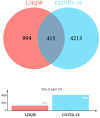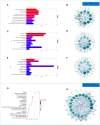Molecular docking and molecular dynamics study Lianhua Qingwen granules (LHQW) treats COVID-19 by inhibiting inflammatory response and regulating cell survival
- PMID: 36506032
- PMCID: PMC9729774
- DOI: 10.3389/fcimb.2022.1044770
Molecular docking and molecular dynamics study Lianhua Qingwen granules (LHQW) treats COVID-19 by inhibiting inflammatory response and regulating cell survival
Abstract
Purpose: 2019 Coronavirus disease (COVID-19) is endangering health of populations worldwide. Latest research has proved that Lianhua Qingwen granules (LHQW) can reduce tissue damage caused by inflammatory reactions and relieve patients' clinical symptoms. However, the mechanism of LHQW treats COVID-19 is currently lacking. Therefore, we employed computer simulations to investigate the mechanism of LHQW treats COVID-19 by modulating inflammatory response.
Methods: We employed bioinformatics to screen active ingredients in LHQW and intersection gene targets. PPI, GO and KEGG was used to analyze relationship of intersection gene targets. Molecular dynamics simulations validated the binding stability of active ingredients and target proteins. Binding free energy, radius of gyration and the solvent accessible surface area were analyzed by supercomputer platform.
Results: COVID-19 had 4628 gene targets, LHQW had 1409 gene targets, intersection gene targets were 415. Bioinformatics analysis showed that intersection targets were closely related to inflammation and immunomodulatory. Molecular docking suggested that active ingredients (including: licopyranocoumarin, Glycyrol and 3-3-Oxopropanoic acid) in LHQW played a role in treating COVID-19 by acting on CSF2, CXCL8, CCR5, NLRP3, IFNG and TNF. Molecular dynamics was used to prove the binding stability of active ingredients and protein targets.
Conclusion: The mechanism of active ingredients in LHQW treats COVID-19 was investigated by computer simulations. We found that active ingredients in LHQW not only reduce cell damage and tissue destruction by inhibiting the inflammatory response through CSF2, CXCL8, CCR5 and IFNG, but also regulate cell survival and growth through NLRP3 and TNF thereby reducing apoptosis.
Keywords: COVID-19; bioinformatics analysis; lianhua qingwen granules (LHQW); molecular docking; molecular dynamics.
Copyright © 2022 Cao, Gong, Wu, Xiong, Chen, Huang, Zhou, Peng, Shen, Qu, Wang and Zhang.
Conflict of interest statement
The authors declare that the research was conducted in the absence of any commercial or financial relationships that could be construed as a potential conflict of interest.
Figures










Similar articles
-
Exploring the mechanism of action of Xuanfei Baidu granule (XFBD) in the treatment of COVID-19 based on molecular docking and molecular dynamics.Front Cell Infect Microbiol. 2022 Aug 10;12:965273. doi: 10.3389/fcimb.2022.965273. eCollection 2022. Front Cell Infect Microbiol. 2022. PMID: 36034710 Free PMC article.
-
Mechanism of Lian Hua Qing Wen capsules regulates the inflammatory response caused by M1 macrophage based on cellular experiments and computer simulations.Acta Trop. 2024 Sep;257:107320. doi: 10.1016/j.actatropica.2024.107320. Epub 2024 Jul 14. Acta Trop. 2024. PMID: 39002739
-
Exploring the mechanism of action of licorice in the treatment of COVID-19 through bioinformatics analysis and molecular dynamics simulation.Front Pharmacol. 2022 Sep 2;13:1003310. doi: 10.3389/fphar.2022.1003310. eCollection 2022. Front Pharmacol. 2022. PMID: 36120307 Free PMC article.
-
Lianhua Qingwen prescription for Coronavirus disease 2019 (COVID-19) treatment: Advances and prospects.Biomed Pharmacother. 2020 Oct;130:110641. doi: 10.1016/j.biopha.2020.110641. Epub 2020 Aug 19. Biomed Pharmacother. 2020. PMID: 34321172 Free PMC article. Review.
-
The Adverse Reactions of Lianhua Qingwen Capsule/Granule Compared With Conventional Drug in Clinical Application: A Meta-Analysis.Front Pharmacol. 2022 Jan 27;13:764774. doi: 10.3389/fphar.2022.764774. eCollection 2022. Front Pharmacol. 2022. PMID: 35153773 Free PMC article. Review.
Cited by
-
Systematic bioinformatics analysis reveals the role of shikonin in blocking colon cancer progression by identifying senescence-induced genes.Front Pharmacol. 2024 Aug 12;15:1360587. doi: 10.3389/fphar.2024.1360587. eCollection 2024. Front Pharmacol. 2024. PMID: 39188951 Free PMC article.
-
Network pharmacology and bioinformatic integrative analysis reveals candidate gene targets and potential therapeutic of East Kalimantan propolis against hepatocellular carcinoma.Heliyon. 2024 Oct 19;10(21):e39142. doi: 10.1016/j.heliyon.2024.e39142. eCollection 2024 Nov 15. Heliyon. 2024. PMID: 39524833 Free PMC article.
-
Exploring the mechanism of Lianhuaqingwen (LHQW) in treating chronic bronchitis based on network pharmacology and experimental validation.Respir Res. 2024 Aug 2;25(1):294. doi: 10.1186/s12931-024-02927-7. Respir Res. 2024. PMID: 39095732 Free PMC article.
-
Curcumin pretreatment attenuates myocardial ischemia/reperfusion injury by inhibiting ferroptosis, autophagy and apoptosis via HES1.Int J Mol Med. 2024 Dec;54(6):110. doi: 10.3892/ijmm.2024.5434. Epub 2024 Oct 4. Int J Mol Med. 2024. PMID: 39364745 Free PMC article.
-
Potential herb‒drug interactions between anti-COVID-19 drugs and traditional Chinese medicine.Acta Pharm Sin B. 2023 Jun 5;13(9):3598-637. doi: 10.1016/j.apsb.2023.06.001. Online ahead of print. Acta Pharm Sin B. 2023. PMID: 37360014 Free PMC article. Review.
References
-
- Apriyanti E., Satari M. H., Kurnia D. (2021). Potential of MurA enzyme and GBAP in fsr quorum sensing system as antibacterial drugs target: In vitro and in silico study of antibacterial compounds from myrmecodia pendans. Comb. Chem. High Throughput. Screen. 24 (1), 109–118. doi: 10.2174/1386207323666200628111348 - DOI - PMC - PubMed
MeSH terms
LinkOut - more resources
Full Text Sources
Medical

